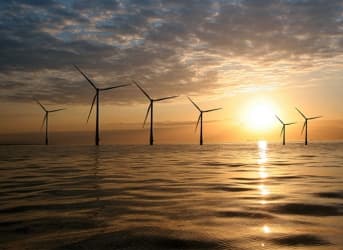Offshore wind has struggled to get started in the United States, but the federal government just announced a plan that could accelerate its development. The U.S. Interior Department announced July 2 that it plans to auction off 80,000 acres off the coast of Maryland for wind development.
In a statement, Maryland Governor Martin O'Malley hailed the decision, saying, “To combat climate change, we must develop cleaner, renewable sources of energy -- and today's announcement is a tremendous step forward for the U.S. offshore wind industry.”
Unlike the onshore wind industry, offshore wind is still in its early stages. Land-based wind farms are already competing with conventional sources of electricity in certain locations. By 2019, an average onshore wind project will cost around $80 per megawatthour (MWh), compared to a new conventional coal plant at $95/MWh, and a conventional natural gas plant at $66/MWh, according to estimates from the U.S. Energy Information Administration.
On the other hand, offshore wind is expected to cost two and half times that, or approximately $200 per megawatthour.
But offshore wind farms do have advantages over land-based wind power facilities -- such as more powerful and consistent wind speeds, and vast, empty territories in which to operate.
The United Kingdom is the global leader for offshore wind, with 3,689 megawatts already installed – more than the rest of the world combined. Statoil, a major Norwegian oil company, just announced plans to build another 402 megawatts of offshore wind on Britain’s eastern coast in the North Sea.
In the U.S. though, offshore wind has been slow to catch on. Cape Wind, a proposed offshore wind project to be constructed near Martha’s Vineyard on the Massachusetts coast, was supposed to be the inaugural offshore wind project in the U.S. when it was proposed in 2001, but it has been bogged down by legal challenges. The proposal has been in limbo for over a decade and become a symbol of the challenges facing offshore wind projects.
But America’s offshore wind industry may finally begin taking some tentative steps forward.
Under former Secretary of Interior Ken Salazar, the government developed the “Smart from the Start” offshore wind program, which aimed to streamline the permitting process. The department also worked with East Coast states to identify “Wind Energy Areas” where wind development could be prioritized.
Related Article: When the Wind Doesn’t Blow
Although Cape Wind was proposed too early to benefit from Interior’s work, its troubles helped spur the government to try and cut the amount of red tape needed for such projects. (A documentary, “Cape Spin,” chronicles the controversy.)
At this point, Cape Wind has survived its legal challenges, acquired the necessary permits, and recently received a $150 million loan guarantee from the Department of Energy. Construction is expected to begin in 2015.
Now, with a clearer permitting regime, the government believes the next generation of wind projects will proceed more smoothly. On August 19, the Interior Department will auction off 80,000 acres of ocean territory in Maryland’s “Wind Energy Area” to 16 qualified bidders for wind projects.
And this is why offshore wind may be at a turning point. Former Secretary Salazar prioritized offshore wind, and now that the institutional capacity is in place, the auctions have begun. There is no certainty that construction will proceed swiftly, but the potential is huge – there are nearly 330 gigawatts of “developable” offshore wind capacity on just the eastern seaboard, almost three times the demand in the mid-Atlantic region.
ADVERTISEMENT
Several states also have renewable portfolio standards that require utilities within their borders to develop clean energy – Maryland is shooting for a 20 percent renewable energy target by 2022. This will spur demand for offshore wind.
If fully developed, Maryland could build between 850 and 1,450 megawatts of offshore wind, enough electricity to power 300,000 homes. State officials also say developing wind in Maryland could support 850 construction and manufacturing jobs, plus 160 permanent jobs to maintain the offshore turbines.
The U.S. government has plans to auction off more Wind Energy Areas in Massachusetts and New Jersey in 2015.
By Nick Cunningham of Oilprice.com


















